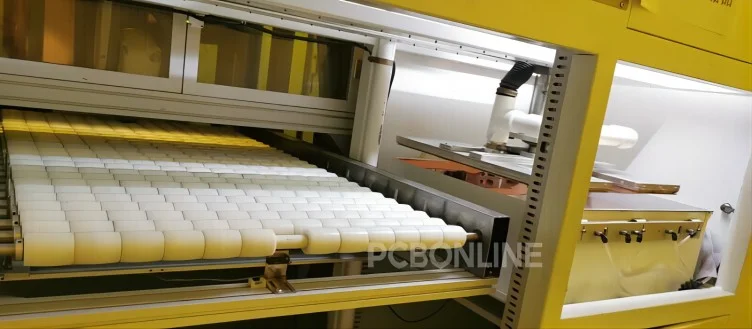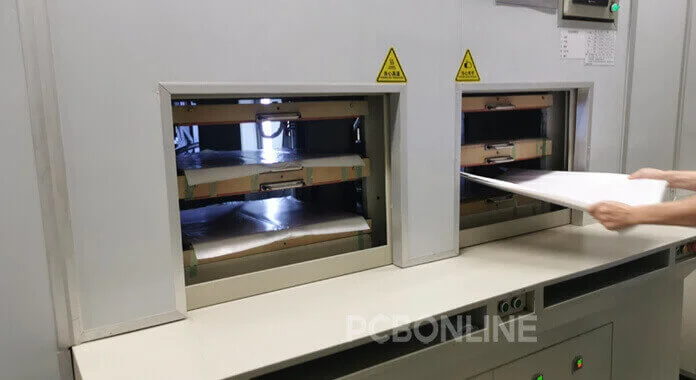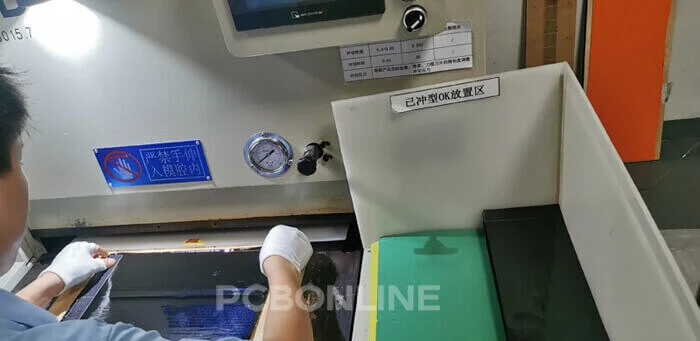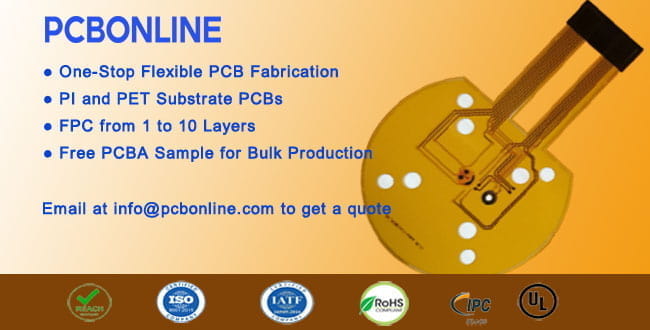Flexible printed circuit boards, or flexible PCBs, or FPC boards, find their applications in more and more fields, such as wearable and display devices, lighting, new-energy car sensors, brakes, switches, batteries, taillights, and so on.

This article reveals FPC boards' stackup, thicknesses, and the FPC fabrication process.
Part 1: FPC Board Stackup
FPC stackup is the structure of flexible PCBs. The stackup of a single-layer FPCis polyimide (PI) > adhesive > copper layer > adhesive > PI.
![]()
A dual-layer double-sided FPC is also very regular and uses a double-sided copper laminate. The stackup of a dual-layer double-sided FPC is PI > adhesive > copper layer > adhesive > PI > adhesive > copper layer > adhesive > PI.
![]()
The stackup of a four-layer double-sided FPCis PI > adhesive > copper layer > adhesive > PI > adhesive > copper layer > adhesive > PI > adhesive > copper layer > adhesive > PI > adhesive > copper > adhesive > PI.
![]()
An FPC can have 1 to 10 copper layers. Of course, an FPC can be made with a larger copper layer number, but it loses flexibility. Besides, the FPC layer number can be an odd number, such as 3 and 5.
![]()
You may notice that FPC boards have a symmetrical stackup. Symmetrical structures allow the FPC boards to keep the warpage as small as possible.
Part 2: FPC Thicknesses
From the flexible PCB manufacturer PCBONLINE, FPC boards have a thickness range from 0.08mm to 1.0mm. The smaller the thickness of the FPC boards, the better flexibility.
The FPC thickness is the sum thickness of PI, adhesive, and copper layers. If the FPC has ink layers, also count their thickness.
From PCBONLINE, the RA or ED copper thickness of FPC boards ranges from 1/3oz to 3z. please note that 1oz equals 35μm.
The FPC copper thickness can be 12μm, 18μm, 35μm, 70μm, and 105μm.
The PI thickness is 12.5μm, 25μm, 50μm, or 75μm.
And the adhesive thickness is 20μmfrom PCBONLINE.
Besides the FPC thickness, the finished FPC width is also a factor you may ask of the FPC manufacturer. From PCBONLINE, the minimum FPC width is 2.36mm.
Part 3: How to Fabricate FPC
How does the FPC manufacturer fabricate FPC boards from raw materials to the finished flex PCBs?
The manufacturer PCBONLINE buys the raw materials - RA or ED copper foil, PI pr PET, and adhesive, presses them into the required thickness, and laminates the PI and adhesive into the coverlay.
![]()
Later, in the FPC factory, we laminate copper foil with coverlay, drill through holes, and VCP electroplate the PTH holes with copper.

Then we transfer the circuit image to the laminate and etch away the unwanted copper.

Next, we drill positioning holes in the laminate and conduct an electrical test on every circuit layer.
And we stack the laminates and coverlays according to the FPC stackup and place the FPC into a lamination machine for lamination.

Now, we print silkscreen on the FPC boards and bake them to get dry.
Next, we apply surface finishes on the FPC pads. The surface finish can be OSP, immersion gold, immersion tin, hard gold plating, ENIG, selective, and carbon ink.
Then we conduct an electrical test on the FPC boards that are almost finished.
Finally, we profile finished FPC boards by cutting the edge rails to separate FPCs on the production panels.

When we finish fabricating the FPC boards, we conduct a visual inspection and sampling testing. Ensuring the FPC quality, we package them according to your requirements.
PCBONLINE, a one-stop FPC manufacturer with two large manufacturing bases and one assembly factory, provides FPC fabrication and assembly from prototype to bulk production. From PCBONLINE, you can have FPC boards manufactured according to your custom needs.

- You can order PI FPC boards and clear PET FPCs of 1 to 6 layers, and rigid-flex PCBs of 2 to 24 layers.
- PCBONLINE can fabricate the FPC boards to be HDI and thick copper (3oz copper).
- We can add PI, FR4, and stainless steel stiffeners to FPCs and rigid-flex PCBs.
- One-on-one engineering support from our CAM engineer with 20+ years of experience throughout your FPC project.
Please feel free to get a quick quote from PCBONLINE by sending your Gerber and FPC quantity by email at info@pcbonline.com.
Conclusion
BGAs use the solder balls in a grid array to replace the pins so that they have a higher circuit density and better thermal dissipation. BGA PCBs are advanced PCBs used for middle and high-end applications, and you can always believe in the design ability and fabrication quality of one-stop BGA PCB manufacturer PCBONLNIE.
©This article is an original work of the PCBONLINE team. Please indicate the author PCBONLINE if you reprint. If the article is reproduced without permission or indicating the author's source, PCBONLINE reserves the right to investigate the infringement.




